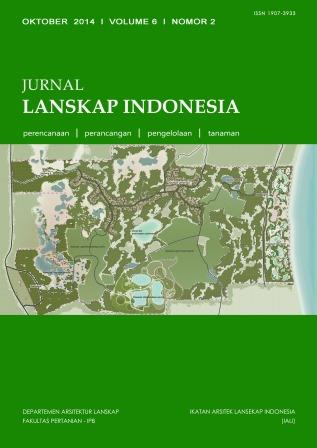PERENCANAAN LANSKAP PEKARANGAN DENGAN SISTEM PERTANIAN TERPADU
Abstract
Home gardens (pekarangan) constitute the potential land to be utilized as productive agricultural land due to their proximity with the people’s house, so that the management of these land is easy. Residents of Teluk Waru hamlet have not optimally utilized their home garden. For optimizing the production of pekarangan, an integrated agricultural landscape was made, with the concept of LEISA and is expected to be able to fulfill monthly appropriate livelihood need (KHL) for residents of Teluk Waru hamlet. In the efforts of optimizing the pekarangan utilization, two alternatives of agribusiness were planned. Lansdcape planning of Pekarangan with integrated farming system concept in the resident’s home garden of Teluk Waru hamlet with land size of 350 m2 showed the following results of agribusiness financial feasibilities: alternative 1 showed NPV of Rp 45.261.784,00, IRR of 111%, and Net B/C of 3,49. Agribusiness of alternative 1 was feasible to be run because of having NPV > 0, IRR above interest rate of 20 % and Net B/C > 1. Analysis results of financial feasibility of alternative 2 agribusiness showed NPV of Rp 72.128.612,00, IRR of 137%, and Net B/C of 4,28. Agribusiness of alternative 2 was feasible to be run because of having NPV > 0, IRR above interest rate of 20 % and Net B/C > 1. In order that the monthly livelihood needs of the famers are fulfilled, the agribusiness of alternative 1 and alternative 2 need minimum land size of 175,57 m2 and 123,82 m2 respectively.Downloads
References
http://www.warintek.ristek.go.id.
(diakses 1 Maret 2009)
LPPM Institut Pertanian Bogor Bekerja
Sama dengan BAPPEDA
KABUPATEN SERANG. 2004.
Usaha Tani Tanaman Semusim
Berskala Komersil Kabupaten
Serang: Kasus Padi dan Kacang
Tanah dan Upaya Optimalisasi
Pemanfaatan Lahannya dengan
Sistem Pertanian Terpadu.
Institut Pertanian Bogor.
Mugnisjah, W. Q. 2000. LEISA: Agribisnis
potensial yang belum mendapat
perhatian secara luas. Bogor.
Mugnisjah, W. Q., Suwarto, dan A. S.
Solihin. 2000. Agribisnis terpadu
berbasis LEISA di lahan basah:
model hipotetik. Buletin
Agronomi, XXVIII (2): 49-61.
Priandono, A. 2006. Perancangan Kebun
Produksi Berbasis LEISA untuk
Pemenuhan Kebutuhan Gizi
Sehat: Kasus Mahasiswa Asrama
TPB-IPB. Skripsi. Program Studi
Agronomi, Fakultas Pertanian,
IPB. Bogor.
Reijntjes, C., B. Haverkort, dan A. Waters-
Bayer. 1999. Pertanian Masa
Depan: Pengantar untuk Pertanian
Berkelanjutan dengan Input Luar
Rendah (terjemahan). Penerbit Kanisius. Yogyakarta.
Saleh. 2003. Pemerintah Perlu Perhatikan
Pertanian Ramah Lingkungan.
Jakarta. Kompas Cyber Media.
(diakses 11 Januari 2008).
Salikin, K. A. 2003. Sistem Pertanian
Berkelanjutan. Penerbit Kanisius.
Yogyakarta.
Saswono, B. 2002. Beternak Kambing
Unggul. Penebar Swadaya.
Jakarta.
Susanto, K. dan R. Widayati. 2007.
Memelihara Ikan bersama Ayam.
Penebar Swadaya. Jakarta.
This journal permits and encourages authors to post items submitted to the journal on personal websites or institutional repositories both prior to and after publication, while providing bibliographic details that credit, if applicable, its publication in this journal. However, after the article is submitted and published in this journal, it is fully copyrighted by the Jurnal Lanskap Indonesia or JLI. If excerpts from other copyrighted works are included, the author must obtain written permission from the copyright owner and give credit to the source in the article. Then, the writer or reader is allowed to copy, share, and redistribute articles/material in any form. But it must still include the appropriate source and credit because the article in this journal is licensed by Creative Commons Attribution 4.0 International License (CC BY 4.0).
I. Proposed Policy for Journals That Offer Open Access
Authors who publish with this journal agree to the following terms:
- Authors retain copyright and grant the journal right of first publication with the work simultaneously licensed under a Creative Commons Attribution License that allows others to share the work with an acknowledgement of the work's authorship and initial publication in this journal.
- Authors are able to enter into separate, additional contractual arrangements for the non-exclusive distribution of the journal's published version of the work (e.g., post it to an institutional repository or publish it in a book), with an acknowledgement of its initial publication in this journal.
- Authors are permitted and encouraged to post their work online (e.g., in institutional repositories or on their website) prior to and during the submission process, as it can lead to productive exchanges, as well as earlier and greater citation of published work (See The Effect of Open Access).
II. Proposed Policy for Journals That Offer Delayed Open Access
Authors who publish with this journal agree to the following terms:
- Authors retain copyright and grant the journal right of first publication, with the work after publication simultaneously licensed under a Creative Commons Attribution License that allows others to share the work with an acknowledgement of the work's authorship and initial publication in this journal.
- Authors are able to enter into separate, additional contractual arrangements for the non-exclusive distribution of the journal's published version of the work (e.g., post it to an institutional repository or publish it in a book), with an acknowledgement of its initial publication in this journal.
- Authors are permitted and encouraged to post their work online (e.g., in institutional repositories or on their website) prior to and during the submission process, as it can lead to productive exchanges, as well as earlier and greater citation of published work (See The Effect of Open Access).



























